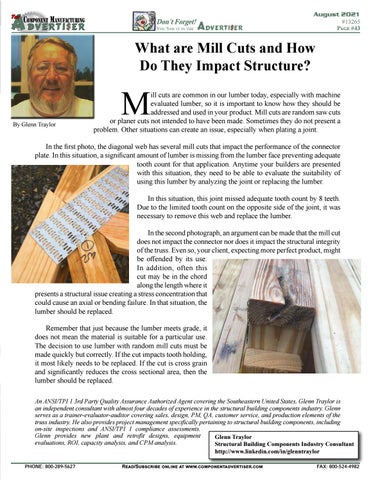A
Th e
Component Manufacturing dverti$ dverti $ er
Don’t Forget! You Saw it in the
Adverti$$er
August 2021 #13265 Page #43
What are Mill Cuts and How Do They Impact Structure?
By Glenn Traylor
ill cuts are common in our lumber today, especially with machine evaluated lumber, so it is important to know how they should be addressed and used in your product. Mill cuts are random saw cuts or planer cuts not intended to have been made. Sometimes they do not present a problem. Other situations can create an issue, especially when plating a joint.
M
In the first photo, the diagonal web has several mill cuts that impact the performance of the connector plate. In this situation, a significant amount of lumber is missing from the lumber face preventing adequate tooth count for that application. Anytime your builders are presented with this situation, they need to be able to evaluate the suitability of using this lumber by analyzing the joint or replacing the lumber. In this situation, this joint missed adequate tooth count by 8 teeth. Due to the limited tooth count on the opposite side of the joint, it was necessary to remove this web and replace the lumber. In the second photograph, an argument can be made that the mill cut does not impact the connector nor does it impact the structural integrity of the truss. Even so, your client, expecting more perfect product, might be offended by its use. In addition, often this cut may be in the chord along the length where it presents a structural issue creating a stress concentration that could cause an axial or bending failure. In that situation, the lumber should be replaced. Remember that just because the lumber meets grade, it does not mean the material is suitable for a particular use. The decision to use lumber with random mill cuts must be made quickly but correctly. If the cut impacts tooth holding, it most likely needs to be replaced. If the cut is cross grain and significantly reduces the cross sectional area, then the lumber should be replaced. An ANSI/TPI 1 3rd Party Quality Assurance Authorized Agent covering the Southeastern United States, Glenn Traylor is an independent consultant with almost four decades of experience in the structural building components industry. Glenn serves as a trainer-evaluator-auditor covering sales, design, PM, QA, customer service, and production elements of the truss industry. He also provides project management specifically pertaining to structural building components, including on-site inspections and ANSI/TPI 1 compliance assessments. Glenn provides new plant and retrofit designs, equipment Glenn Traylor evaluations, ROI, capacity analysis, and CPM analysis. Structural Building Components Industry Consultant http://www.linkedin.com/in/glenntraylor PHONE: 800-289-5627
Read/Subscribe online at www.componentadvertiser.com
FAX: 800-524-4982
